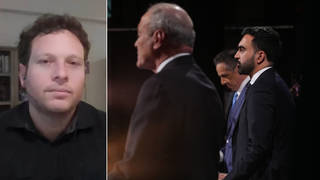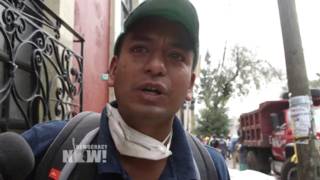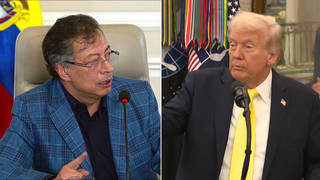
Topics
Guests
- Laura Carlsendirector of the Mexico City-based Americas Program of the Center for International Policy.
In Mexico, a massive 7.1-magnitude quake struck 100 miles southeast of Mexico City Tuesday, collapsing dozens of buildings around the capital city and trapping schoolchildren, workers and residents beneath the rubble. At least 217 people are dead, and hundreds more are missing. Among the dead are least 21 students at a primary school in Mexico City and 15 worshipers who died during a Catholic mass when the earthquake triggered an eruption at a volcano southeast of the city. The disaster struck just hours after residents participated in an earthquake preparedness drill marking the 32nd anniversary of a 1985 earthquake that killed 5,000 people. Tuesday’s quake follows another earthquake less than two weeks ago, which killed at least 90 people and leveled thousands of homes after it struck near the coast of the southern state of Oaxaca. We speak with Laura Carlsen, director of the Mexico City-based Americas Program of the Center for International Policy.
Transcript
JUAN GONZÁLEZ: We begin today’s show in Mexico, where a massive 7.1-magnitude quake struck 100 miles southeast of Mexico City Tuesday, collapsing dozens of buildings around the capital city and trapping schoolchildren, workers and residents beneath the rubble. At least 217 people are dead, and hundreds more are missing. Among the dead are least 21 students at a primary school in Mexico City and 15 worshipers who died during a Catholic mass when the earthquake triggered an eruption at a volcano southeast of the city.
AMY GOODMAN: The disaster struck just hours after residents participated in an earthquake preparedness drill held to mark the 32nd anniversary of the 1985 earthquake that killed 5,000 people. Tuesday’s quake follows another earthquake less than two weeks ago, which killed at least 90 people and leveled thousands of homes after it struck near the coast of the southern state of Oaxaca.
For more, we go directly to Mexico City to speak with Laura Carlsen, director of the Mexico City-based Americas Program of the Center for International Policy.
Laura, thanks so much for taking time to speak to us. I know you, yourself, had to relocate. Can you describe the scene in Mexico City?
LAURA CARLSEN: Well, Amy, it was a terrifying moment. For anyone who hasn’t felt a major earthquake, it’s a deeply humbling and horrifying experience. I was on the roof of a very old building in the downtown area when we began to feel the movement. The alarm went off almost at the same time as the earthquake started, because there was no prior warning and the epicenter was so close to Mexico City. So we had to go down two flights of fire escape-type stairs. We didn’t know if we could hold on. It was swaying so heavily.
By the time we got out in the street, the streets were filled with people. There was glass. There was dust and the smell of gas in the air. People were crying inconsolably and hugging each other. There’s still a lot of people, you have to remember, who recall the 1985 earthquake and when thousands died and they lost relatives. So, there’s a real deep trauma in Mexico City whenever this happens. We had one less than—just about 10 days ago. So, it was—people were very, very scared. Most of them were in the streets. There was no communication, for the most part, so they were worried about relatives and trying to get a hold of loved ones that they didn’t know what had happened to them.
JUAN GONZÁLEZ: Well, what is the situation in terms of power, electricity, and water there and the damage to the infrastructure, as far as you can tell? And you mentioned the ’85 earthquake. There was much criticism of the Mexican government at the time for its slow and haphazard response to that disaster.
LAURA CARLSEN: Right. Well, there was no electricity. There’s still no electricity in a good part of the city. There’s also no phone service in a lot of the city. We finally got some phone service and some electricity, as you can see, back. But that’s still a crisis for many people. Of course, when it’s dark, it creates a security situation. But for the most part, things have calmed down quite a bit here right now.
The criticisms of the government—the government is trying to avoid that this time, and they’re acting. But as always, for the most part, it’s the people who are going out there on the rescue missions and taking control of helping others, taking people into their homes, because there’s a lot of homeless people now.
AMY GOODMAN: The building next to you, Laura, collapsed?
LAURA CARLSEN: Yeah, just five blocks away, an entire building collapsed. And that’s, of course, when you have the biggest danger and when people are trying to get the rubbles cleared away so that they can find out if there are people trapped in there. There are a lot of people that are disappeared. My friends have cousins that they’re still searching for—unfortunately, one who died. So there’s going to be a couple days here at least of digging out and trying to find more survivors.
AMY GOODMAN: You arrived a year after the September 19th, 1985, earthquake in Mexico City. How eerie is it that this earthquake comes on the 32nd anniversary of that quake that killed 5,000 people? Can you talk about the stories of the people you chronicled from then?
LAURA CARLSEN: I think people are really traumatized by that coincidence. They feel like there’s some kind of terrible fate about it, in some ways. And again, as I mentioned, it recalls those terrifying memories.
When I got here, the city was still in ruins. A large part of the city was in rubble, across the entire city. And people were still trying rebuild, trying to find housing. I began working with the September 19th seamstresses organization, because there was a section of town where the sweatshops were, and that section of town was particularly hard hit. The buildings fell. The owners wouldn’t let the women out of the buildings. When the rubble—you could hear cries coming out of the rubble. The owners arrived to rescue their material and their safes, and they left living bodies, which caused a huge reaction among the populace. And it was why the union was able to form a women’s union, an independent union.
What happened out of that earthquake was that despite the terror and the fear, there was a huge coming together of the society, that’s marked Mexican society since then, this capacity to stand up and say, “I’m going to risk my own life,” because going into this rubble is dangerous. You have to know what you’re doing. And there’s always a danger of being out there. “But I’m going to risk my own life. I’m going to give my own time to try to rescue people.” This year, just last night at 10:00 at the university, they had a call, and they asked young people to come and take a short training to be a rescue worker. And thousands showed up at the university. They’re all over the city trying to help out, with water, with flashlights, and see if they can find any more survivors in the shortest term possible.
AMY GOODMAN: Well, we want to thank you so much for joining us, Laura Carlsen. Thank you for joining us from Mexico City. And, of course, we’ll keep people updated. Again, the latest number is something like 217 people dead, but it’s believed hundreds of people are missing in this earthquake, in Mexico City and beyond.












Media Options